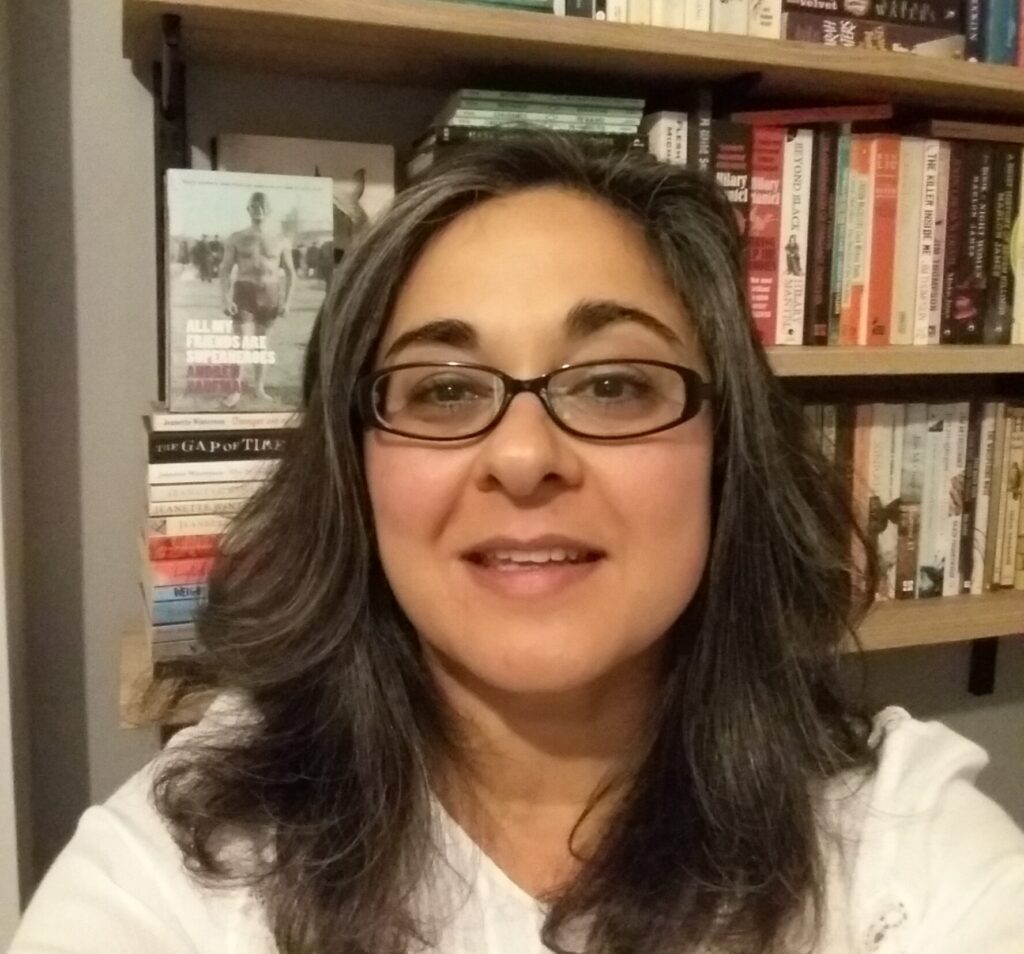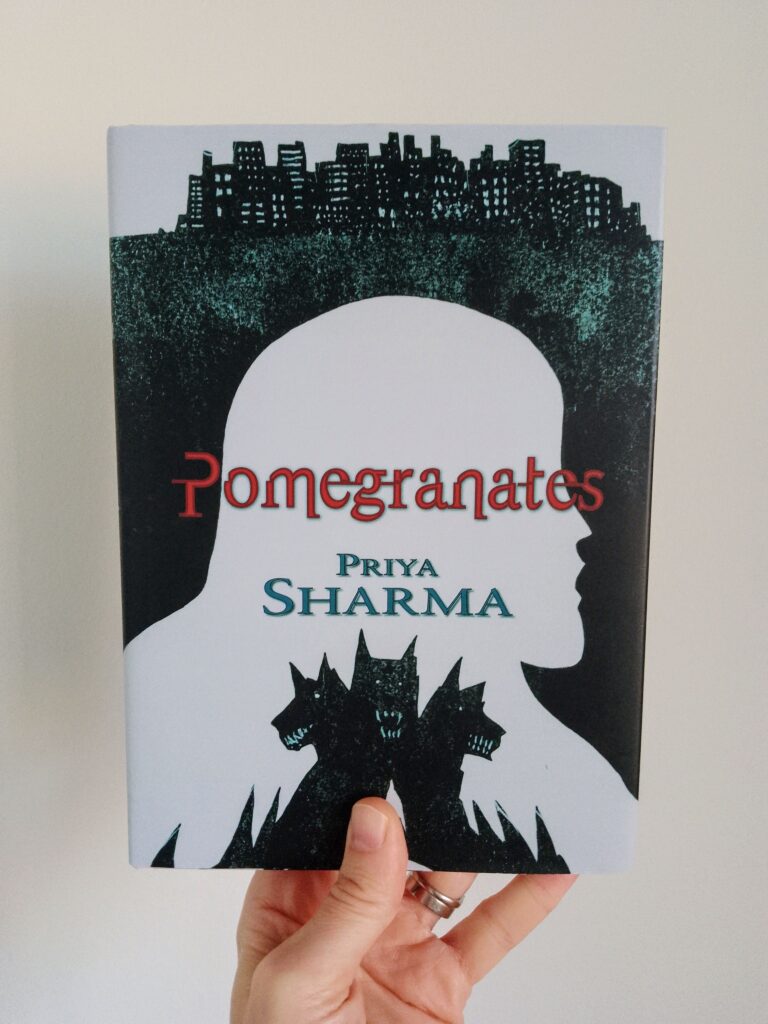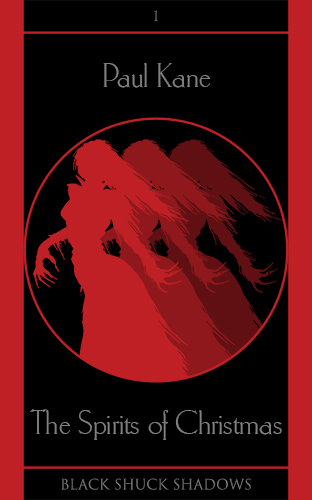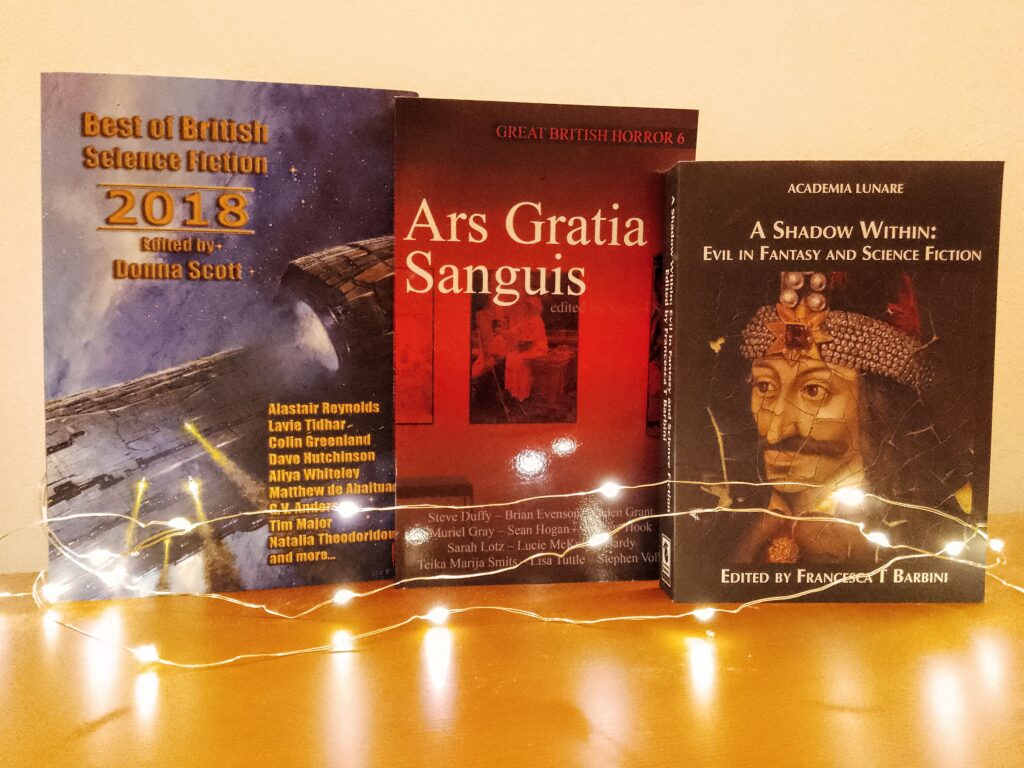Last month saw the publication of my water-themed dark fantasy micro collection, Waterlore, by the ever-excellent Black Shuck Books. As Steve Shaw, the publisher, tends to publish these nifty collections in pairs, Waterlore was paired with The End by Kayleigh Dobbs, which was lucky for me because I got to read The End early and have fun chatting to Kayleigh as we organized an online launch for both of our collections (which I blogged about here).

Sadly, due to technological issues (damn Facebook Live!), the launch didn’t quite go to plan… and since Kayleigh and I weren’t able to properly co-host the live launch we ended up going solo (which was, of course, rather nerve-wracking!). But everyone attending was very understanding and supportive, and so somewhere on Facebook there exists two separate videos of Kayleigh and I doing our very best to keep going with the launch! Aside from the technical bumps being annoying, the greatest annoyance for me was not being able to properly chat to Kayleigh, and our guests, the lovely Priya Sharma and Black Shuck Books star, Steve Shaw. Thankfully they’ve all been very kind and agreed to answer the kind of nosy questions I was going to ask them “on air”. Enjoy!

Kayleigh Dobbs
1. The End is a terrifying, though highly entertaining, micro collection of six short stories on the theme of the apocalypse. Why were you drawn to this theme, and can you tell me about the process of writing the collection?
Why, thank you! I was drawn to the theme because apocalyptic fiction is one of my absolute favourite genres of horror – perhaps my most favourite. For some reason, I find the thought of the end of the world peaceful. However, most apocalyptic fiction I find is post-apocalyptic, and doesn’t deal with how the world is brought down, rather the aftermath. I wanted to explore the “how”.
The process of writing it came about because of my favourite band, Periphery. Their song ‘Reptile’ inspired the first story in the collection, ‘The Claim They Stake’, and then listening to their music inspired all the rest of the stories too.
2. Considering how frightening the theme of the apocalypse is, your stories are infused with a lot of warmth and humour. Is that something you very consciously decided to do with your stories, or is this always a part of your writing style?
I think it might just be a part of my writing style or my subconscious sort of bleeding through. I intentionally wrote ‘Just Like Baking’ and ‘Dead’ to be humorous, but I’m told quite often that my more typical horror stories also have a bit of a funny twang to them sometimes.
3. As a well-known reviewer of horror books over at Happy Goat Horror, how does it feel to be the writer whose work is being reviewed?
It’s a lovely change! And I really appreciate every single review, social media post, and conversation of any kind about any of my work. It’s nice to read a positive review but I also really appreciate them even if they’re negative because the reader is still supporting me in taking the time to post their thoughts. I’m a big believer in balance with things like this.
4. How did you come to be aware of Black Shuck Books, and which was the first Black Shuck Shadows micro collection you read?
Ooh gosh, I actually don’t remember which Black Shuck Books book I first came across, I’ve been reading them for so many years. It’s likely that I discovered them at a Horror Con, or through another indie author. I was invited to contribute to Great British Horror 3: For Those in Peril, which was very flattering. The first Shadows book I read was definitely Kit Power’s Voices (which is excellent by the way).
5. In terms of writing, what are you working on now?
That elusive, troublesome first novel. I don’t want to talk about it much because it’s still very far from being ready, but it’s a sort of folk horror. A nasty one.
6. Lastly, if someone’s new to the horror genre and wants a recommendation for a short story, novella, and novel, what would you recommend?
OH GOD WHY ARE YOU DOING THIS TO ME?! I’m furiously thinking through the million great stories I’d love everyone to read. I’m sorry but I have to do 3 for each! Okay…
Short Story:
‘The Debts We Owe’ (Phil Sloman, from No Happily Ever After)
‘Just a Note’ (Brennan LaFaro, from Illusions of Isolation)
‘The Moth’ (Rachel Knightley, from Twisted Branches)
Novella:
The Bucket List (Mark Towse and Chisto Healy)
The Finite (Kit Power)
We Haunt These Woods (Holley Cornetto)
Novel: Sorry sorry sorry but I simply had to put 5 for this one!
The Silence (Tim Lebbon)
Last Days (Adam Nevill)
Milk (Adam Millard)
House of Hunger (Alexis Henderson)
The Silent Companions (Laura Purcell)
May I add a Book Series? – Dave Jeffery’s A Quiet Apocalypse books are absolutely outstanding.
Many thanks, Kayleigh! You can find out more about Kayleigh here:
*

1. Your latest published work is the excellent and scary-as-hell novella Jack O’Dander, which is published by Tor Books. How did the seed of the story come to you, and how did you grow it into the creepypasta/crime story that it is?
Hi Teika. Thank you so much or your kind words. I’d been watching a documentary about Peter Sutcliffe. One of the women he’d murdered was Wilma Mary McCann. Her son, Richard, was interviewed. He’d been a child when she went missing. Listening to him talk about his life was very moving. He and his siblings were put in care. His sister committed suicide. Those awful crimes had ongoing effects.
I was thinking about those left behind after someone goes missing, especially children. The key to writing the story was working out the dynamics of the main relationships in the story. I was interested in culpability and guilt.
I didn’t consciously set out to write a creepypasta story, but I don’t see how you can write a modern urban myth story without using social media.
2. After reading your novella, I immediately Googled Jack O’Dander to find out more because it felt like I’d always been aware of this terrifying character. Do you have any insights as to creating characters that really resonate with readers?
Jack is a trope for predators, which might be why he feels familiar. I don’t think you can ever guess what will resonate with other people, so I write for myself.
What’s scary is subjective, isn’t it? The one thing you do have control over is what terrifies your character. If you can convince the reader of your character and their reasons for being scared of what’s coming, then you’re winning.
3. As well as Jack O’Dander, you’re the author of various award-winning books – Ormeshadow, All The Fabulous Beasts, Pomegranates. Does this kind of recognition help or hinder you when you sit down to write?
I have been very fortunate in this to date and am grateful. I still find writing daunting. Not, how do I write, but how do I write this story? The best thing you can do is set aside all praise and damnation, and then focus on the work.

4. I know that art often inspires your stories. Can you tell me a little bit more about this?
I find art and images inspirational. Sometimes I build a Pinterest board for a story to help me write. It sparks all sorts of ideas and connections.
Sometimes a painting has inspired a whole story. “Thesea and Astaurius” (Interzone/ Issue 246) was based on Picasso’s Minotaur Caressing the Hand of a Sleeping Girl with his Face. I fell in love with it when I saw it in the Picasso Museum in Malaga. The story is an alternative myth where Theseus is actually a women called Thesea. It’s a love story, of sorts.
‘The Ghost of a Flea’ was a short story that I wrote based on the William Blake painting of the same name. It appeared in Screams from the Dark: 29 Tales of Monsters and the Monstrous (Nightfire), edited by Ellen Datlow. It featured William and Catherine Blake, whose lives were fascinating, so it was a gift to write.
5. In terms of writing, what are you working on now? (And dare I ask if there’s a novel in the pipeline…?!)
I wish that I could tell you – there’s a few short stories I need to focus on for next year.
I have a novel developing in my head and am researching. Time will tell on that one.
6. Lastly, if someone’s new to the horror genre and wants a recommendation for a short story, novella, and novel, what would you recommend?
That’s a tough question. I’d want to know what they liked. Crime? Romance? I’d use that as a gateway to then lure them in – horror comes in all stripes.
If they’re completely new and aren’t sure what they like, I’d direct them to anthologies. That’s a good way to find the type of horror and the writers that click with you. There are loads of good ones out there, both themed and unthemed, by editors like Ellen Datlow, Paula Guran, Steve Shaw, Mark Morris, Marie O’Regan, to name a few.
Also, the indie press scene is exciting – PS Publishing, Undertow Publications, Black Shuck Books, Luna Press Publishing, for example.
Thank you very much, Priya! You can find out more about Priya here:
Priya Sharma’s fiction has appeared in venues such as Interzone, Black Static, Nightmare, The Dark and Tor.com. ‘Fabulous Beasts’ won a British Fantasy Award for Short Fiction. She won a Shirley Jackson Award and British Fantasy Award winner for her short story collection All the Fabulous Beasts (Undertow Publications). Her novella Ormeshadow (Tor.com), won both a Shirley Jackson Award and a British Fantasy Award, and was a 2022 Grand Prix de l’Imaginaire finalist. Her stories have been translated into Spanish, French, Italian, Czech, and Polish. Her latest novella Pomegranates (PS Publishing) won a World Fantasy Award and was a British Fantasy Award and Shirley Jackson Award finalist.
priya sharma fiction (wordpress.com)
*

of Black Shuck Books
1. Black Shuck Books is a respected and well-loved indie publisher of the horror genre. How did you go about setting up the press?
It all started with a Facebook post by Theresa Derwin. Back in 2014, Theresa asked if anyone would be interested in editing an anthology for Knightwatch Press. I’d previously given the idea some thought, so dropped her a note saying that yes, I’d be interested, although I had no experience whatsoever. Fortunately that wasn’t a problem, and although I didn’t end up editing that book, I did ultimately take over Knightwatch Press, which then became Black Shuck Books.
2. And how did you come up with the idea of the wonderful Shadows series? Did you set out to design each cover with a repeating image within a circle? (Because it’s incredibly effective.)
Black Shuck Shadows came about as the result of two ideas. Firstly, Paul Kane approached me in 2016 and asked if I would like to produce an ebook of his three Christmas ghost stories. Having said yes, I then thought that if I was releasing an ebook, I might as well put together a paperback as well. I grew up with the smaller format books that were the stock in trade of Pan, Fontana, New English Library, etc., and because the book clocked in at just 20,000 words, it seemed appropriate to format it at that size. My other thought was that single author collections from small presses can often be quite expensive, and it can be off-putting for a reader to have to spend £25-30 on a book by someone whose work they may not be familiar with. So the idea of Shadows as a series was to offer a few pieces of an author’s work for a relatively small price, as a pocket-sized sampler.
The first few Shadows books had a different style of cover, although the repeating image concept was there from the beginning. Each book has a number of silhouettes – that number matching the amount of stories in the book – which gradually fade to black. If I’m honest, I can’t now remember what prompted that design, but it seems to be working…

3. Speaking of design… all the covers of Black Shuck Books are beautiful. They seem to be a great fit for the stories within. How do you go about pairing the cover art with a writer’s work?
Sometimes the appropriate image is fairly obvious: with your own Waterlore collection, for example, or Reggie Oliver’s Stages of Fear, there seemed to be a clear choice for what worked (water and footlights, respectively). Others, such as Brian Evenson’s Black Bark or George Sandison’s Hinterlands, take an image from one of the included stories. I’ve always been a fan of rotational symmetry, which is why so many of the covers have that particular style.
4. You’re currently closed to submissions, so how can an author catch your attention?
I’m in a very fortunate position, because (anthology stories aside) I haven’t had to seek out work to publish. A lot of my annual schedule gets filled up following conversations which start out along the lines of “I’ve had this odd idea…”. That’s definitely the way to get my attention – throw something peculiar or curious at me, and I’ll likely be interested.
Having said that I’m not exactly open to submissions, I’m always willing to hear about unusual ideas that authors may have. I’ve often said that the best thing I can hear from an author is “…but of course, no one would publish it” – if you’ve written something that you feel that way about, you know where to find me…
5. Lastly, if someone’s new to the horror genre and wants a recommendation for a short story, novella, and novel, what would you recommend?
That depends on whether you’re asking for recommendations of works I’ve published, or works in general…
I’ve published over 300 short stories so far, a number of which rank among my favourite pieces of all time. If I can stretch the rules slightly and nominate two, I would go for Stephen Volk’s ‘The Waiting Room’ (in Great British Horror: Ars Gratia Sanguis) and Alison Littlewood’s ‘The Flowering’, which appears in both her Shadows book of the same name and in her collection A Curious Cartography. Both of these are sublime pieces of Victoriana, completely different and yet oddly alike. For novella I’ll go with The Incarnations of Mariela Peña by Steven J Dines, a zombie tale unlike any you’ll ever have read before, and for novel it has to be Sean Hogan’s Twilight’s Last Screaming, a mammoth project featuring characters from across American horror film colliding with each other in an overarching, apocalyptic narrative.
In terms of recommendations from the wider horror world, I’ll again go for a mixture of styles. Two of my absolute favourite short stories (and short story writers) are ‘The Master Builder’ by Christopher Fowler – a claustrophobic nightmare of homeownership – and ‘In the Hills, the Cities’ by Clive Barker, which I’ve reread multiple times and never fail to be amazed by the peculiarity of Barker’s imagination. We Have Always Lived in the Castle by Shirley Jackson may push the boundaries of novella length somewhat, but it is one of the finest pieces out there. Jackson is obviously best known for The Haunting of Hill House, which is an excellent story in its own right, but which is surpassed on every level by the later book. Finally, Stephen King’s IT may be an obvious choice, but it’s the right one. It remains, after maybe a dozen rereads, my favourite novel, and the only book which I cried at the end of, because I didn’t want it to be over.
Thank you very much, Steve! You can find out more about Black Shuck Books here:
*

In lieu of a Q&A from me, I’ve done something different… Below you’ll find some of the text from the Story Notes section of Waterlore, which hopefully gives the reader a sense of how I came to put together the collection. There is also a rather random observation about my book, a couple of shout-outs and a giveaway.
“Some time ago, when I began to seriously contemplate putting together a short story collection, I created an Excel spreadsheet and listed within it all the short stories I’d written over the years. When I began to study the spreadsheet, I discovered that many of the stories were set in or around bodies of water and featured some of the fantastical creatures we usually associate with the sea. There weren’t enough stories for a full collection, but there were enough for a micro collection, and given the fact that I’m a huge fan of the Black Shuck Shadows series, I wondered if, just maybe, Steve of Black Shuck Books might be interested in publishing what I had already begun to think of as Waterlore.
Of course, I’m not the first writer whose imagination has been captured by the mysteries of water – indeed, no. 3 of the Shadows series, the wonderful Unquiet Waters by Thana Niveau, draws on the same inspiration – and yet, I’d like to think that there’ll always be a (pardon the pun) thirst for such stories. Besides, these tales are not simply about our relationship with the sea, they are also an exploration of love and selfhood, guilt and regret, and, ultimately, acceptance. Maybe, even, forgiveness.”
Rather random observation…
Each story features a drink (of sorts). Here they are:
‘Lady Seaweed or Tristesse’ – brine (or perhaps breastmilk?)
‘Golden Dreams’ – a cocktail called a Golden Dream that’s made with Cointreau and Galliano
‘The Pirate and the Selkie’ – a pirate’s favourite: rum!
‘Screaming Sue’ – the narrator’s/interviewee’s tipple is scotch
‘The Sea Wasps’ – “saltwater rich in iodine”. Yum!
‘Ghost Fish’ – an americano with a side of chocolate cake (which happens to be the author’s favourite too)
‘Rusalka or Waterlore’ – a Bohemian drink, slivovice (plum brandy)

Shout-out
At the launch I was hoping to mention Penny Jones – her micro collection, Suffer Little Children, was the first Shadows book I bought and I was really impressed by these powerful stories and her handling of the theme. So do check it out if you haven’t already. I also wanted to give a shout out to Kate Garrett, whose poetry pamphlet, Deadly, Delicate inspired one of the stories in Waterlore, ‘The Pirate and the Selkie’. Again, do seek out Kate’s writing if you’ve not come across it as yet.
Giveaway
At the online launch I’d planned to give away 3 books. Since that never happened, I’m doing it now, via the blog. Each book includes a piece of my writing, alongside some brilliant short stories/essays. To be in with a chance of winning one, simply leave a comment telling me about one of your favourite horror stories or novels. Or share with us what frightens you… cue evil laugh… mwa ha ha! The deadline is 31st December 2023 and I will pick three winners at random. Good luck and thanks for reading!

I think the concept of liminal spaces are quite terrifying, although I can’t name one book in particular.
I love the idea of liminal spaces too – they’re super scary! (And I think that they appear in my writing quite often – in a kind of Jungian way.) Thanks for stopping by and commenting. 🙂
I love the atmosphere of the Carnacki stories. There’s always that scene where he has scouted the haunted site, set up his devices, and then settles down for a tense night of waiting, alone in the darkness.
And we wait with him, of course, wondering if this time he might have bitten off more than he can chew…
I love the Carnacki stories too! And I’ve even been known to write the odd one myself… Thanks for dropping by. 🙂
I’ve been mulling over the brilliance that is “Hippocampus “ by Adam L G Nevill for a while. It’s a horror story with no characters. You can read it online here: https://pseudopod.org/2019/02/01/pseudopod-633-hippocampus/
Ooh, thanks for the recommendation. 🙂 Much appreciated! Will check that out!
I have always been drawn to folklore and the dark side of fairy stories. I enjoy a story that uses darkness within a person to draw darkness out of others. I also don’t like everything explained so I can use my imagination. Forget a happy ending!
I love the darkness within fairy tales and folklore too. It’s definitely my kind of thing! Did you mean that you like how the darkness in one person brings out the darkness in another in that they encourage others to be their worst selves? Or that they bring out the darkness and help another person to be a better version of themselves? I’m intrigued… And I know that they’re not for everyone, but I still like a happy ending from time to time. 🙂
Recently I read an old story called ‘Hypnos’ by H.P. Lovecraft, and was struck by how good he was at creating an incredibly spooky atmosphere in a sparse environment. In this case, a man sleeping in a dark room. It’s a genuinely creepy tale.
Thanks for the recommendation! I feel like I’m rather lacking in my knowledge about the stories of H.P. Lovecraft – I need to address that! Thanks for the reminder and for stopping by. 🙂
I find there’s something very chilling and troublesome about the uncanny valley, from slightly too-realistic animation, to disfigured ghosts. Something about these creeps makes you intrigued by their horror, which often is a little too closely entwined with reality.
Oh yes, I totally agree! I find the uncanny valley really creepy too. Thanks for stopping by and commenting. 🙂
Hey folks, just wanted to say thank you all for taking part in my giveaway! The first name I pulled out of the hat was Writer Incognito, then Alan Nash, and finally Thea. I will email each one of you with regards your bookish prizes. 😀